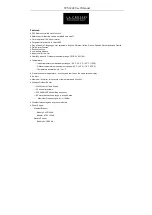
12
batteries are sufficient for most climates. We do not recommend
rechargeable batteries. They have lower voltages, do not operate well at
wide temperature ranges, and do not last as long, resulting in poorer
reception.
Best Practices for Wireless Communication
Note:
To insure proper communication, mount the remote sensor(s)
upright on a vertical surface, such as a wall.
Do not lay the sensor flat.
Wireless communication is susceptible to interference, distance, walls and
metal barriers. We recommend the following best practices for trouble free
wireless communication.
1.
Electro-Magnetic Interference (EMI)
. Keep the receiver one
meter away from computer monitors and TVs.
2.
Radio Frequency Interference (RFI).
If you have other 433
MHz devices and communication is intermittent, try turning off
these other devices for troubleshooting purposes. You may need to
relocate the transmitters or receivers to avoid intermittent
communication.
3.
Line of Sight Rating.
This device is rated at 100meter line of
sight (no interference, barriers or walls) but typically you will get
30meter maximum under most real-world installations, which
include passing through barriers or walls.
4.
Metal Barriers.
Radio frequency will not pass through metal
barriers such as aluminum siding. If you have metal siding, align
the remote and receiver through a window to get a clear line of
sight.
The following is a table of reception loss vs. the transmission medium.
Each “wall” or obstruction decreases the transmission range by the
factor shown below.













































